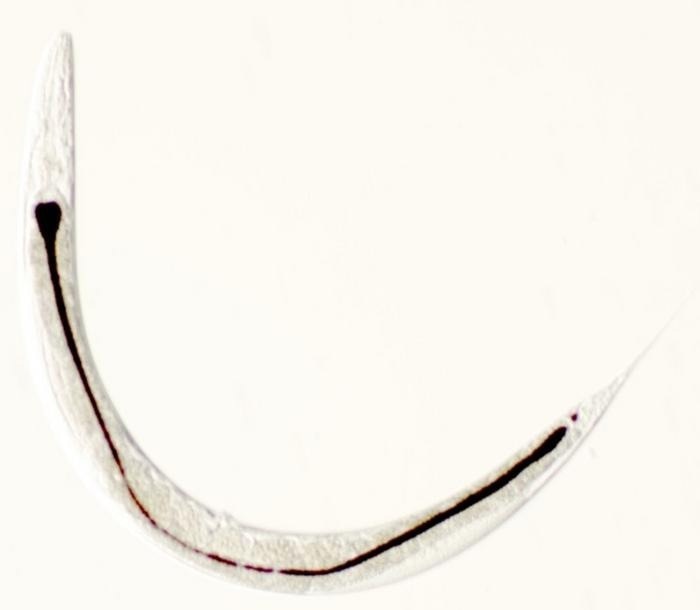A research team headed by Assistant Professor Yajuan Zou and Research Professor Masazumi Fujiwara of Okayama University in Japan has created a polymer coating that can be applied to NPs to minimize ecotoxicity, according to a study published in the journal Chemosphere.

Nanoparticles coated with the hydrophilic polyglycerol polymer with the negative charged groups were able to pass through the nematode’s intestine more freely and be excreted from their bodies. Image Credit: Masazumi Fujiwara from Okayama University
Nanoparticles (NPs) are often employed to minimize environmental pollution by targeting hazardous substances in soil and water that are generated during industrial and agricultural processes.
These nanoparticles are designed to absorb, dissolve, or neutralize contaminants, offering a potential remedy to environmental pollution. However, when released into the environment, they can be ingested by species and passed down the food chain, causing extensive harm.
NPs’ binding characteristics can be altered by changing their surface chemistry and electric charge. Adding hydrophilic groups to the NP surface forms a barrier that prevents binding to biological substances and cell surfaces.
While positively charged NPs are known to collect more in organisms due to their attraction to negatively charged cell surfaces, new research indicates that negatively charged NPs may accumulate more than positively charged NPs.
In their study, published online on April 20th, 2024, the researchers created a polyglycerol (PG) covering with a negatively charged group. This coating was applied on iron oxide NPs (ION) and was discovered to efficiently minimize the accumulation of iron oxide particles in Caenorhabditis elegans, a nematode commonly used as a model organism in environmental chemistry.
The study co-authors were Prof. Fujiwara, Dr. Zou, and Dr. Yuta Nishina from Okayama University, Dr. Yutaka Shikano from Tsukuba University, and Dr. Naoki Komatsu and Dr. Eriko Kage-Nakada from Kyoto University.
We have demonstrated that PG grafting was an effective approach to reduce the accumulation and to suppress the translocation of ION in C. elegans, which consequently alleviated the toxic outcomes such as reproductive potential and survival ratio.
Masazumi Fujiwara, Research Professor, Okayama University
The researchers coated iron oxide nanoparticles (ION) of various sizes—20 nm, 100 nm, and 200 nm—with polyglycerol (PG) to create ION-PG, aiming to evaluate the effectiveness of the coating across a range of nanoparticle sizes. These ION-PG particles were then suspended in a solution, and Caenorhabditis elegans nematodes were introduced. The worms, at various lifecycle stages from larvae to adults, allowed the researchers to track nanoparticle accumulation throughout their development. A control group was exposed to a suspension containing uncoated ION. After 24 hours of exposure, the worms were collected, washed, and examined for accumulated nanoparticles within their bodies.
The PG coating prevented nanoparticles from adhering to biomolecules, enabling them to pass more freely through the nematode’s intestine and be excreted from their bodies. Nematodes exposed to ION-PG showed lower levels of nanoparticles in their bodies compared to the control group. The smallest nanoparticles, capable of easily traversing the worms, were not detected.
Furthermore, the researchers explored the influence of charge groups on nanoparticle bioavailability. They introduced positively charged amino groups and negatively charged carboxyl and sulfate groups to the ION-PG and repeated the experiment. They observed that negatively charged particles passed through the worm more readily than positively charged particles due to high electrostatic repulsion against the negatively charged cell surface and low affinity to biomolecules in the nematode.
Consequently, the coating alleviated the toxicity associated with ION-PG. The researchers noted enhancements in both reproductive capacity and lifespan among the group exposed to ION-PG compared to the group exposed to uncoated NPs.
The researchers note that the new coating can also be applied to other NPs utilized in environmental remediation, such as graphene oxide and titanium dioxide.
Dr Fujiwara added, “Our findings are expected to promote the design and production of large amounts of eco-friendly nanomaterials for environmental applications.”
This advancement holds promise for addressing environmental challenges and aligns with the UN Sustainable Development Goals, particularly Goal 3 (good health and well-being) and Goals 14 and 15 (conservation of water and land).
Journal Reference:
Zou, Y., et. al. (2024) Size, polyglycerol grafting, and net surface charge of iron oxide nanoparticles determine their interaction and toxicity in Caenorhabditis elegans. Chemosphere. doi:10.1016/j.chemosphere.2024.142060.